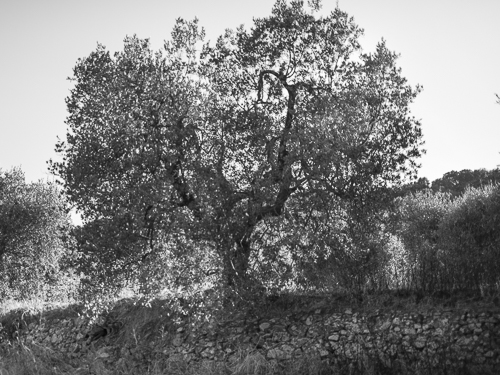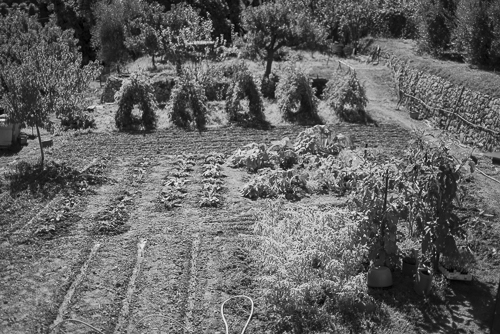Unfortunately, in the past farmers were quite often growing grapevines of low quality in the hills above the town of Porto Ercole and many of them just gave up, removing the grapevines. However, there are still vineyards and olive groves in active use in this area alternating with forests creating picturesque combinations of colours.
Having ascended a curvy and steep road, passing various wine cellars which had been closed, we arrived at one which was open. In fact, we followed a man called Miro to his small farm high up on the hill. Miro is aged 70 years and he’s still growing grapevines and he has a small wine cellar in his house where he lives with his family. The farm was founded in 1900 by his grandfather who worked as a mason all his adult life. He built the house with the wine cellar and he excavated a well in order to provide for the need for water by his family and the farm, including a vineyard which he planted and maintained the last years of his life.
Miro is continuing the tradition started by his grandfather, cultivating Ansonica, which gives a white wine, and Sangiovese, which gives a red wine.
Since the summer of 2018 was very hot, the grapes were mature in August, leading to that the grapes were harvested before our arrival. However, we were invited to visit his wine cellar where he willingly opened one of the tanks containing wine which wasn’t mature yet.
Originally, there were other types of grapevines in this area, but Miro told us that in centuries past, pirates arrived, raiding and destructing everything, including native grapevines, which gradually disappeared. However, some of the people of Porto Ercole were seafarers and arriving at various ports in Italy, they discovered a grape which was adapted to this area: Ansonica. It’s a grape which is able to grow in long periods of drought and hit by winds bringing salt from the sea, which encircles this pretty promontory.
This farm is called Ceciario and it’s specialised in cultivating grapevines and olive trees, harvesting the fruits and making wine and olive oil.
Until 60-70 years ago, people were practising agriculture from a little above sea level to near the top of the hills looming above Porto Ercole. Naturally, the agriculture wasn’t limited to growing grapevines and olive trees as of now where it’s still practised.
In fact, families were living on the hill and from watching the few existing farms and abandoned ones, given the steep terrain, it was necessary to construct terraces in order to keep the soil from being washed away by heavy rain after long periods of drought. Unfortunately, most of the terraces are falling down and disappearing, being replaced by Mediterranean maquis.
Setting up the terraces required almost superhuman efforts. First, it was necessary to dig out stones which were big enough t be used for making stone walls by means of harrows, hoes and pickaxes. Having excavated a large amount of stones, it was time to construct a solid wall, which should be able to withstand the outward pressure of soil and plants on the inside. Since the soil on the hills was thin and poor, it had to be transported upwards from fields at the base of the hills. The workers also had to bring animal dung to the soil in order to use it as fertiliser. In order to provide for a whole family, it was necessary to cultivate vegetables, vineyards, olive trees, fruit trees, cereals and legumes. If they had animals, they had to grow fodder for them too. Naturally, it was also necessary to have a source of water.
Unfortunately, the stone walls on the farm of Miro are not , in general, in good condition and parts of them have already fallen down. On the other hand, nature reclaims what it has lost.
Anyway, it’s important and interesting to get to know how things were done in the past before the arrival of machines. For instance, some polished stones protruding from the basement had been put there when it was being made. Miro told us that they were used by his grandfather for grinding tools.
Next day we went to visit another family who were living higher up on the same hill as Miro: the Giacomini family consisting of Grazia and Massimo. The house was built by Grazia’s great-great grandfather such that Grazia is the fifth generation living in this house.
They willingly showed us their property consisting of plots being supported by stone walls, while their dog followed us everywhere. Originally, a creek passed this property and a water mill was used to grind grain, turning it into flour. Unfortunately, the creek had disappeared and the water mill had been demolished.
Instead, the stone walls supporting the plots looked vertical and solid, but they have to be maintained in order to support the weight of the soil and plants, else they will fall down sooner or later.
The Giacomini family were growing vegetables, aromatic herbs, citrus trees and fruit trees on the terraces. An incomplete list follows:
- basil
sweet and spicy chili pepper
white and black cabbage
squash
tomatoes
fennel
lemon
oranges
peach
sage
rosemary
satureja
laurel
The property is quite small and the products from the cultivation are consumed by the Giacomini family and their guests.
Next, we went upwards in order to visit Emilia, an elderly lady who lives alone after her husband died. As we were approaching her house, we could see a vineyard, which seemed to be of good quality, but Emila isn’t able to maintain the grapevines, like her husband was doing. Thus, the vineyard will gradually be replaced by Mediterranean maquis if not someone else will maintain it.
Like the property of the Giacomini family, there was a water mill on this property too. Below the house, there was a big arc which supported a cupola with two holes through which water from a creek had been flowing, driving the water mill. There were also workbenches and tools for woodworking and a big saw hanging on the wall. In addition, there were tanks and bottles for storing wine.
After our visit, we went to a former farm, which had been converted into a second home for people living elsewhere. Only some olive trees were remaining, while the old farmhouse had been replaced with a modern one. The terraces, which had been used for agriculture, had been turned into terraces for sunbeds located around a swimming pool in which a robot was cleaning the bottom occasionally.


